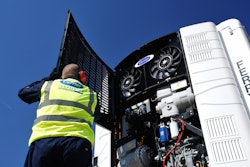
Take a moment to observe the number of gadgets, screens and devices that are in your immediate line of sight. If it wasn’t obvious before, it is undoubtedly clear to you now that our lives have been slowly taken over by technology.
Over the last few decades, innovators and disruptors alike have employed technology to reimagine daily life – the way we work, the way we raise our families, even the way we eat is ever-impacted by the evolution of and accessibility to the latest advancements in technology. Transactions have never been easier, access to information has never been faster; the efficiency and sheer convenience technology continues to introduce to our world cannot be understated.
Technology’s Challenge
It goes without saying, technology’s influence on the cold chain logistics industry is equally profound. From the implementation of temperature monitoring to the optimization of product put-away and selection, technology has and always will be an industry game changer. The challenge we face as cold chain logistics providers is leveraging that technology to bring efficiency and optimization opportunities to our customers’ businesses.
At Lineage Logistics, we are constantly looking for ways to utilize technology and other optimization strategies to deliver value along our customers’ extended supply chains. Across our facility network, critical technologies and systems like sensors and automation help us to gather and analyze critical data that inform solutions to our customers’ most challenging logistics needs.
As an example, the Lineage Logistics facility in Santa Maria, Calif. deploys hundreds of temperature sensors in its receiving, storage and shipping areas to provide constant visibility into the operations of the refrigerated systems and to help maintain quality control. From the data collected via these sensors, managers are able to make adjustments to the system to minimize temperature variability, protecting customers’ product and dramatically decreasing our energy bills. In addition, the system can predict when maintenance of the systems will be required and avoid costly shutdowns.
Inbound and Outbound Opportunities
The consolidation of the cold chain logistics industry that has occurred during the last decade (and is expected to continue in the near-term future) also resulted in great opportunities for companies to optimize the performance of their customers’ supply chains. For instance, the increased scale of newly combined companies provides improved routing solutions for both inbound and outbound transport, dramatically reducing empty trailer miles and yielding other benefits.
Lineage, for instance, can now tap its larger network of facilities to more accurately match backhauls and fronthauls to make the supply chain more efficient and environmentally sustainable. This system will be extended to match the shipping profiles of the customers’ trading partners in the near future, providing additional channels to ensure that as many trailers as possible are traveling full, improving profits and reducing waste.
In addition, because retailers and suppliers want product delivered in tighter time windows, but also want to reduce out of stocks and limit excess stock at the store, cold chain logistics companies need to have better visibility to product movements. Deployment of technologies that can track and trace product from pasture to plate give logistics providers the capability to support complex and changing supply chains.
Efficiency Impacts Quality
Lastly, automation has the potential to significantly increase capacity and reduce energy consumption at cold chain distribution facilities. Such product handling and related technologies also will improve food quality and product consistency by optimizing the handling of goods in harsh environments like extreme cold. Automation helps distributors increase throughput, decrease scheduling errors and lower labor and energy costs.
Other benefits include better productivity, a critical value-add when there is a labor shortage, and more flexible methods of product handling on the same line.
Cold chain logistics is dynamic, and the impact of technology on the industry continues to unfold. But while it is often challenging to keep up with the revolving door of technological advancements, it’s clear we must drive innovation in our companies to be successful in the future.
Sudarsan Thattai is CIO of Lineage Logistics. He has more than 17 years of experience leading technology operations and initiatives across large-scale organizations like UTi Worldwide, Cisco Systems and DFS Group.

















